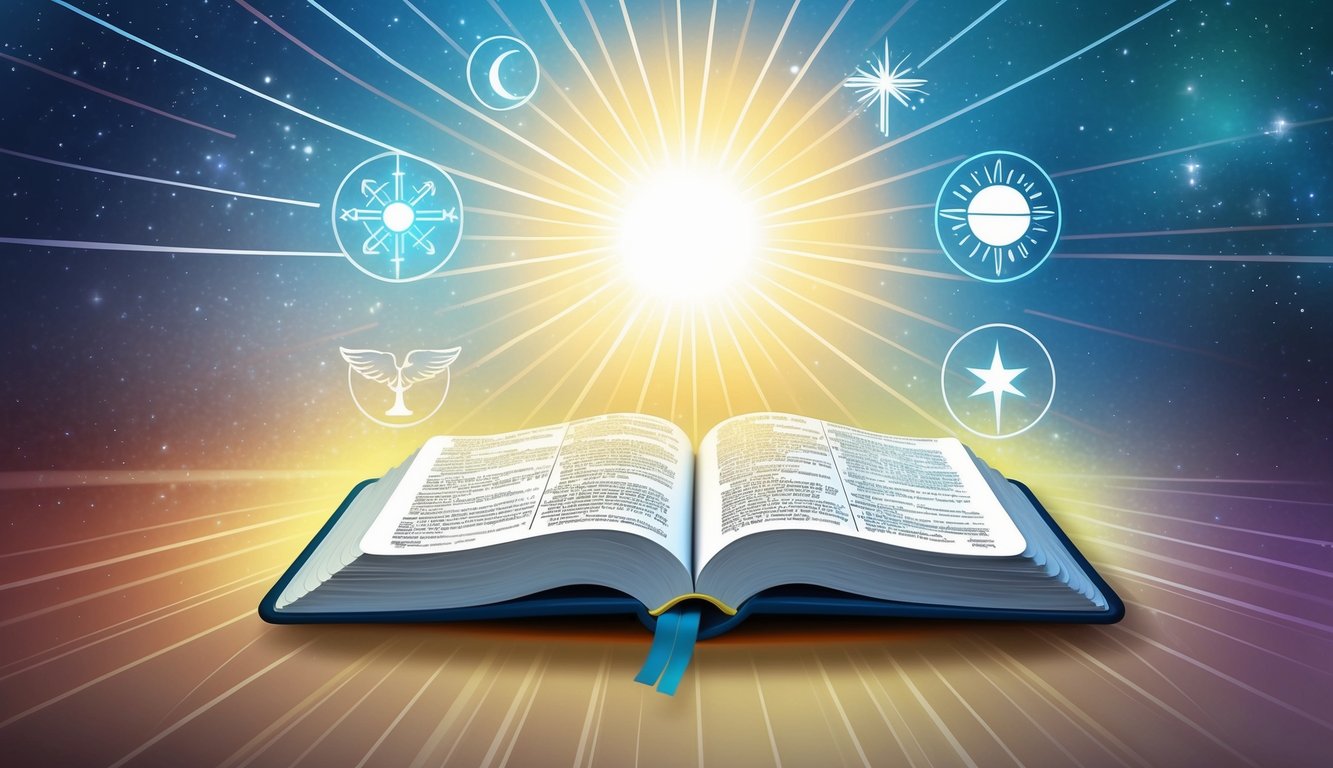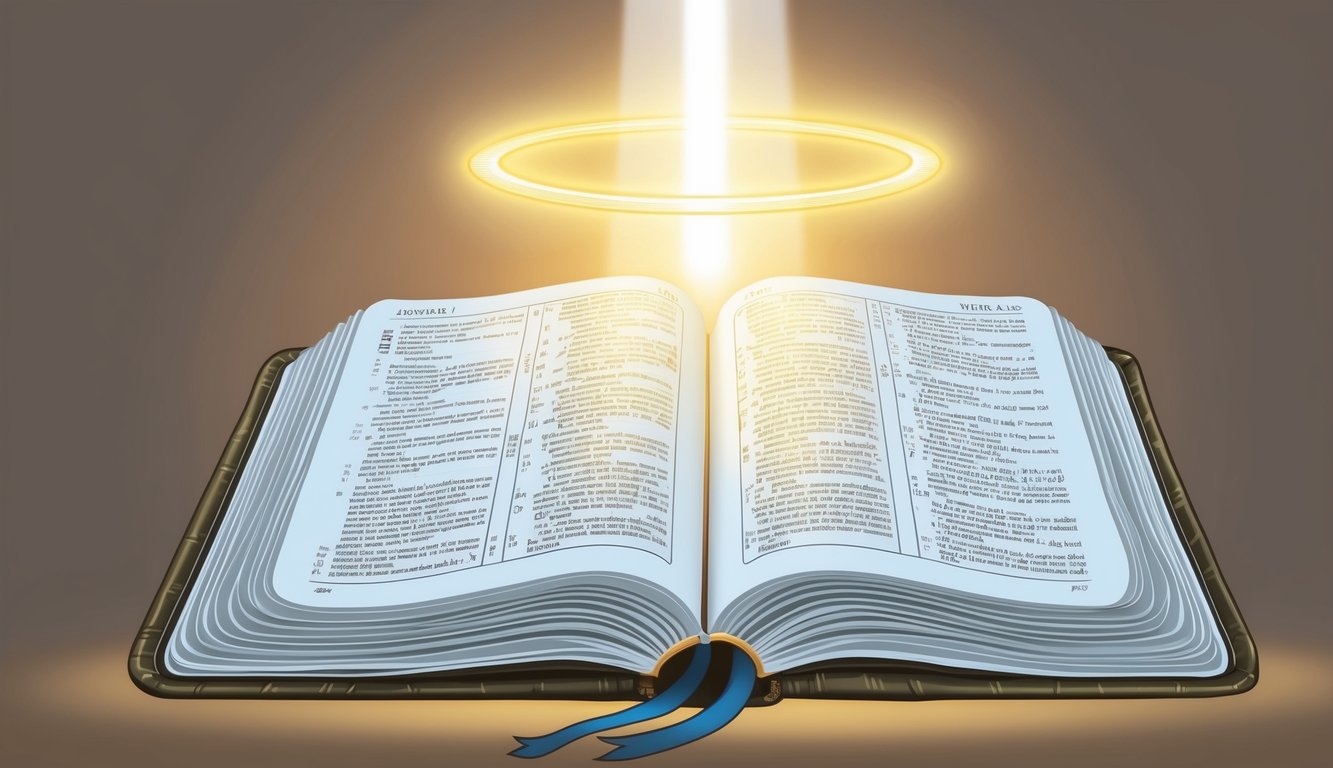Don’t Miss Out On This Unique Astrological Opportunity
Are you tired of spinning your wheels and getting nowhere? Simply put, you’re out of sync: you’re out of alignment with your astral configuration.
But: there’s a kind of map that can help you reclaim your alignment. Think of it as your own personal blueprint to success and happiness: a blueprint that will help you live your most amazing life.
Get started here.
Some people wonder about the concept of the Rapture and what the Bible says about it.
Biblical passages discuss how believers will meet Christ at His return. The Bible describes the Rapture as a pivotal event where believers are transformed and caught up to meet Jesus.
This topic includes verses from the New Testament, such as 1 Thessalonians 4:16-17, which detail how believers will join Christ in the clouds.
The idea of the Rapture offers hope and encouragement, reminding believers to be prepared for this extraordinary event.
Exploring these scriptures can provide insight into the signs and symbols associated with the Rapture.
These passages offer believers guidance on what to expect and how to remain spiritually prepared.
By studying the rapture scriptures in the Bible, one can gain a deeper understanding of the prophetic events described in both the Old and New Testaments.
This exploration can strengthen faith and provide clarity on the divine promise of Christ’s return.
Understanding the context and significance of these verses may help deepen your faith and provide assurance in times of uncertainty.
Key Takeaways
- The Bible describes the Rapture as a significant future event.
- Key scriptures offer details about meeting Christ during His return.
- These verses offer hope and remind believers to stay prepared.
Theological Context of Rapture
The concept of the rapture involves Christ’s return and the gathering of believers.
It’s rooted in prophecy and linked to significant events like the Tribulation and the Second Coming.
Biblical eschatology and key scriptures offer a comprehensive outlook on these events and their spiritual significance.
Rapture in Christian Eschatology
In Christian eschatology, the rapture is seen as a pivotal event where believers are taken up to meet Jesus Christ.
This belief is often tied to passages in 1 Thessalonians 4:16-17, which describes Christ descending from Heaven.
The event marks a time before the Tribulation when believers experience rescue from impending devastation.
Discussions around the timing of this event vary.
Some believe it precedes the Tribulation, known as the pre-tribulation rapture, while others view it as occurring mid-tribulation or post-tribulation.
This diversity in viewpoint reflects different interpretations of scriptural references to the Lord’s return and the final Judgment.
Old Testament Prophetic Roots
The Old Testament holds prophetic roots for the idea of the rapture, although not explicitly mentioned by name.
Prophecies often refer to the Messiah and a coming age where God’s people will experience deliverance.
Genesis 3:15, for instance, alludes to future victory over evil through the coming of Christ.
Other prophets, like Daniel and Isaiah, speak of times of Tribulation and divine intervention.
These passages lay groundwork for later theological understandings of events like the rapture and contribute to interpretations in the New Testament about immortality and rescue.
Rapture and the Second Coming
The rapture and the Second Coming are linked but distinct events in Christian theology.
The rapture involves believers being caught up with the Lord, whereas the Second Coming refers to Christ’s return to Earth to establish His Kingdom.
Some scholars see the rapture as preceding or coinciding with this event in Revelation.
These events highlight Judgment and the fulfillment of God’s promise.
It’s a time when believers meet Christ and the world undergoes transformation, leading into a new era defined by His reign.
Key Rapture Passages
The Bible contains several passages that discuss the concept of the rapture.
These texts reveal different facets of this event, each offering unique insights.
Key references include letters from Paul, words from Jesus in the Gospels, and John’s apocalyptic vision.
1 Thessalonians 4: The Central Passage
In 1 Thessalonians 4, Paul describes a moment when believers will meet Christ in the air. 1 Thessalonians 4:16 mentions a trumpet call and the voice of an archangel.
This passage vividly depicts the rapture, making it central to discussions on the topic.
It emphasizes hope for Christians, providing a promise of joining Christ.
With phrases like “caught up” in 1 Thessalonians 4:17, this section lays out the hope and anticipation of believers.
Understanding this passage gives you insight into the early Christian view on the end times.
The Gospels’ Perspective on the End Times
The Gospels share Jesus’ teachings on the end times.
In Matthew 24:29-31, Jesus speaks of gathering the elect after a period of tribulation.
It’s a dramatic description, with celestial disturbances and angels gathering believers. Luke 17:34-37 similarly illustrates sudden changes, often interpreted as aspects of the rapture or final judgment. John 14:3 offers comforting words, with Jesus promising to prepare a place for his followers.
These passages underscore the significance of vigilance and faithfulness.
Revelation’s Vision of the End
Revelation provides apocalyptic imagery surrounding end times events. Revelation 3:10 offers a message of protection for the faithful during times of turmoil.
This text addresses perseverance and a promise to those who remain true.
Revelation charts a complex sequence of events, but some see parallels to rapture themes within its prophecies.
Its vivid symbolism and prophetic language offer a broader view of how the world’s final days could unfold, giving you a dramatic picture of future events.
Corinthians and the Mystery of the Rapture
In Corinthians, Paul talks about the mystery of the rapture. 1 Corinthians 15:51-52 describes a transformation happening “in a flash, in the twinkling of an eye.” Paul outlines the change of believers into imperishable forms at the final trumpet. Corinthians presents the rapture as a sudden, transformative event.
This discussion of mystery underscores the unexpected nature of this event and its transformative promise.
Paul’s writings here expand upon his teachings from Thessalonians, with an emphasis on hope and transformation for believers.
Signs and Symbols

Rapture-related biblical verses often contain vivid imagery and symbols.
These elements illustrate the events and messages associated with the end times, including celestial changes and spiritual beings.
Interpreting Apocalyptic Imagery
Apocalyptic literature in the Bible frequently uses symbolic imagery to convey messages about the end times.
For instance, changes in the Sun, Moon, and Stars often symbolize cosmic disturbances.
These elements can signify a shift in divine power and authority, with such imagery being found in Revelation and prophetic books like Daniel.
The use of Clouds often represents the presence of divine beings.
Clouds can symbolize God’s presence, acting as a divine vehicle during significant biblical events, such as when believers are said to be caught up in the clouds to meet the Lord.
The Role of Angels and the Archangel in Rapture
Angels play a crucial role in the rapture narrative.
They are often seen as messengers or agents of God, guiding and protecting believers.
In the context of the rapture, an Archangel’s voice is mentioned, signaling the gathering of the faithful.
This element is critical, as the voice serves as a divine announcement for believers to rise and meet the Lord.
The Trumpet is another key symbol associated with angels in the rapture.
Its sound signifies the call for the Dead in Christ to rise.
This act of rising indicates their transformation and journey to heavenly realms, highlighting the importance of the trumpet’s sound.
Cosmic Disturbances and Divine Presence
Cosmic disturbances feature prominently in biblical descriptions of the end times.
These events involve dramatic changes, such as the light of the Sun and Moon diminishing or Stars falling from the sky.
Such descriptions often signal the coming of a divine presence or significant spiritual event.
Readers can see these disturbances as representing God’s intervention in the world.
The changes serve as markers for the faithful, indicating that spiritual transformation is imminent.
This imagery aligns with rapture theology, suggesting a profound shift in reality as believers anticipate meeting the Lord with divine guidance.
Practical Insights and Encouragement

The rapture offers hope and encouragement to live a purposeful life focused on eternal values.
By understanding key teachings, you can stay vigilant and prepared, drawing comfort and motivation from the promise of the rapture.
Living with Eternity in Mind
Embrace the idea of living with eternity in mind by focusing on spiritual growth.
This concept encourages you to think beyond daily challenges and prioritize your relationship with God.
In Titus 2:13, the anticipation of the “Day of the Lord” is described as the “blessed hope,” urging believers to live according to higher principles.
This perspective can transform your outlook on life, emphasizing eternal rewards. Preparing a place for you in heaven signifies a personal connection with God, inspiring you to live rightly today while remaining mindful of what lies ahead.
The Call to Vigilance and Preparedness
Scriptures like Matthew 24:42 and phrases like “twinkling of an eye” and “not all sleep” stress the need for vigilance and readiness.
Staying spiritually awake involves practicing mindfulness and self-discipline to ensure you are ready for Christ’s return at any moment.
Daily decisions should reflect a preparation for eternity.
The concept of being ready is reinforced by phrases such as “watch,” “signs,” and “be prepared.” These are not just warnings but invitations to deepen your faith, focusing on actions that align with spiritual preparedness.
Comfort and Motivation in the Promise of Rapture
The promise of the rapture, as highlighted in 1 Corinthians 15:52, offers comfort and motivation for believers.
The phrase “in the twinkling of an eye” conveys sudden transformation and a future beyond earthly struggles.
This assurance can serve as a source of strength, helping you remain steadfast through life’s uncertainties.
The mysteries revealed in scriptures, like the idea of resurrection, provide a hopeful outlook, encouraging you to share this comfort with others.
By focusing on these promises, you can find the courage to face each day with hope, knowing there’s a destined future filled with divine joy and peace.
Frequently Asked Questions

Understanding rapture Bible verses involves exploring different parts of the New Testament.
Key passages include letters from Paul and apocalyptic descriptions, highlighting both the event of the rapture and its implications for believers and non-believers.
What does 1 Thessalonians say about the rapture?
1 Thessalonians 4:16-17 often gets cited regarding the rapture.
It describes how believers will be caught up in the clouds to meet the Lord in the air.
This passage offers comfort and hope about being united with Jesus.
How is the rapture described in the book of Revelation?
The book of Revelation provides vivid imagery and symbolism regarding the end times.
While it does not explicitly use the term “rapture,” it includes descriptions of events that some interpret as related to the rapture, such as the gathering of God’s faithful.
Which verse in Corinthians is associated with the rapture?
1 Corinthians 15:51-52 is associated with the rapture.
It mentions a mystery where believers will be changed in the twinkling of an eye at the last trumpet.
This passage speaks of transformation and victory over death through resurrection.
Are there Bible verses that describe what it’s like to be left behind after the rapture?
Verses that discuss being left behind focus on the separation between believers and non-believers.
Matthew 24:40-41 illustrates this concept, describing two people working together, with one taken and the other left.
In what way does the Bible reference the Second Coming of Christ?
The New Testament frequently references the Second Coming of Christ.
Verses like Matthew 24:30 depict Jesus returning with power and glory.
This event is seen as a fulfillment of prophecy and offers hope for final redemption.
How do Christians interpret the event of the rapture?
Christian interpretations of the rapture vary.
Some Christians view it as a literal catching away of the faithful, while others see it as symbolic of spiritual truths.
These views often depend on different theological frameworks, such as pre-tribulation or post-tribulation perspectives.



